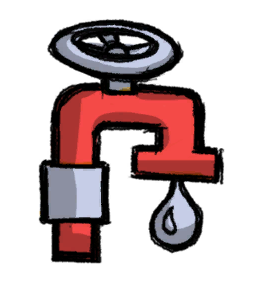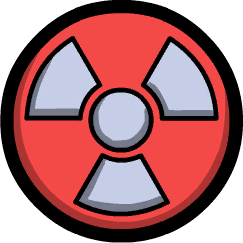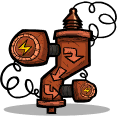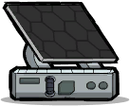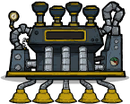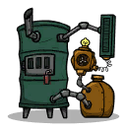Natural Gas Generator
Natural Gas Generator uses Natural Gas to produce electricity, and releases Carbon Dioxide through attached Gas Pipe, and dribbles Polluted Water on the third tile from the left. Natural Gas has to be brought in through a Gas Pipe connected to the input tile of the generator. Getting the gas into the pipe will require a Gas Pump. The gas must be pure - any "packet" of a wrong kind of gas will damage the generator.
Natural Gas Generators produce 1.25 kDTU, 2.8 g of CO2, and 8.4 g of Polluted Water per 100 Joules of electrical energy.
Usage
Natural Gas generators are a good source of power that do not require maintenance. It would also be a good idea to place them relatively near a Natural Gas Geyser so the pipes do not have to travel far, and that the Carbon Dioxide can be more efficiently separated and put off to the side, where it can be contained or purified.
The outputted polluted water is emitted on the Natural Gas Generator's third tile from the left or second tile from the right. A single mesh tile on that location can allow you to direct the outputted polluted water.
Heat economy
- Polluted Water is produced with minimal temperature of 40 °C/104 °F.
- Carbon Dioxide is produced with minimal temperature of 110 °C/230 °F.
Both outputs can be hotter if the generator is hotter than their minimal temperatures.
Due to SHC output/input ratio of 1.5, Natural Gas Generators are inherently heat multiplying. However those effects can be mitigated by keeping input's temperature as close as possible to 40 °C/104 °F. It is preferable to err on the upper side, since colder input will boost heat at double rate.
- With 20 °C/68 °F input it produces 19.4 kDTU/s
- With 40 °C/104 °F input it produces 15.5 kDTU/s
- With 60 °C/140 °F input it produces 17.2 kDTU/s
(building's passive heat output included)
Synergy with Steam Turbines
As the Natural Gas Generator does not release Carbon Dioxide into the environment, a Steel Natural Gas Generator can be built inside a Steam-filled room and feed its heat output directly to a Steam Turbine. At 150°C (matching the output of a Natural Gas Geyser), a generator produces about 25.6 kDTU/s in net heat - of which about 2.86 kDTU/s is in the Carbon Dioxide pipe, while the remaining 22+ kDTU/s can be fed directly to the turbine. A single self-cooling steam turbine can handle the heat production of about 12 generators, and will produce around 300W of additional power, and also ease Temperature Management (It should be noted that Tune-Up Generator Rooms is likely more efficient).
This also boils the Polluted Water as soon as it exits the generator - due to the small individual quantities involved, it is 100% converted to Steam, making this as efficient water-wise as a Water Sieve but without using power or Filtration Medium. This steam can be retrieved as clean Water via the turbine output. Unlike most steam turbine designs, output water should not be reintroduced to the steam chamber by default - as most of the heat from the generator is produced by increasing the thermal mass in the chamber, re-adding water will cause the steam temperature to drop below 125°C and the turbine will stop functioning. Instead, key the turbines to activate based on room pressure, and only reintroduce liquid when needed (above 135 °C for a self-cooled turbine, or above 200 °C for actively cooled setups).
Tips
- One Oil Refinery or nine Fertilizer Synthesizers produce enough Natural Gas for one Natural Gas Generator.
- One Gas Pump can pump 500 g/s of Natural Gas, which is enough to supply 5.55 Natural Gas Generators.
- Consequently, one pipeline (kg/s) can feed 11 generators, with one bonus generator for every 9 pipelines.
- 44 natural gas generators will saturate a carbon dioxide waste pipeline.
- The [Oil Well -> Crude Oil -> Petroleum -> Sour Gas -> Natural Gas -> Water Sieve] Pathway leads to the production of excess polluted water (1:1 of the mass of Petroleum used). If a Sour Gas Boiler can process 2kg/s of Petroleum, it will be able to produce enough natural gas to run 15 generators.
- Ten Natural Gas Generators can consume the excess Natural Gas produced by twenty-seven properly-maintained Oil Wells.
- As most seeds are unlikely to contain that many Oil Reservoirs, simpler ratios can be used that will not have full uptime on the generators. One generator can handle all output from 1-2 wells, two generators can handle 3-5 wells, and three generators can handle 6-8 wells.
- As seen on sprite of the Natural Gas Generator as a spout, the Polluted Water is produced in the tile that is second from the right. Building a Mesh Tile right below this tile is enough to prevent a messy spill.





